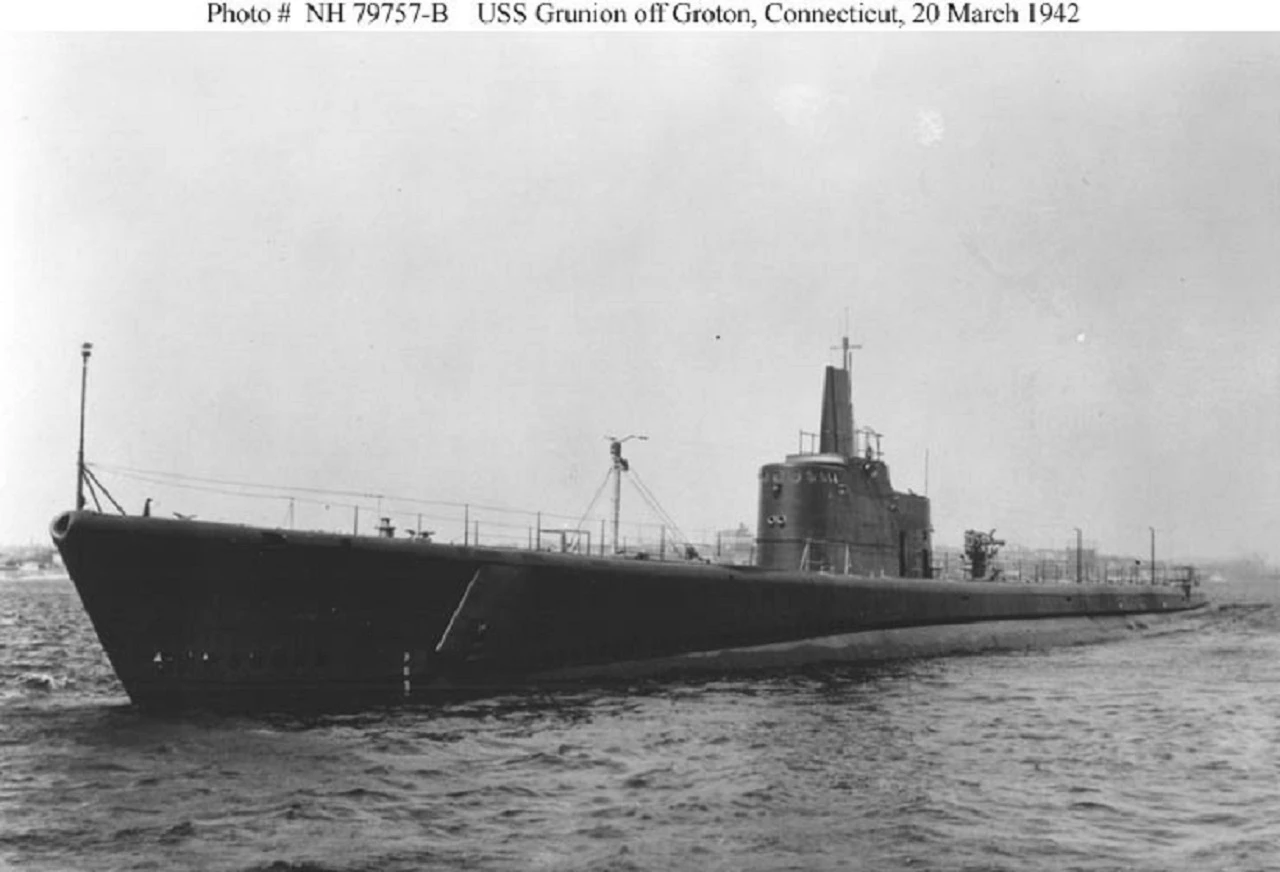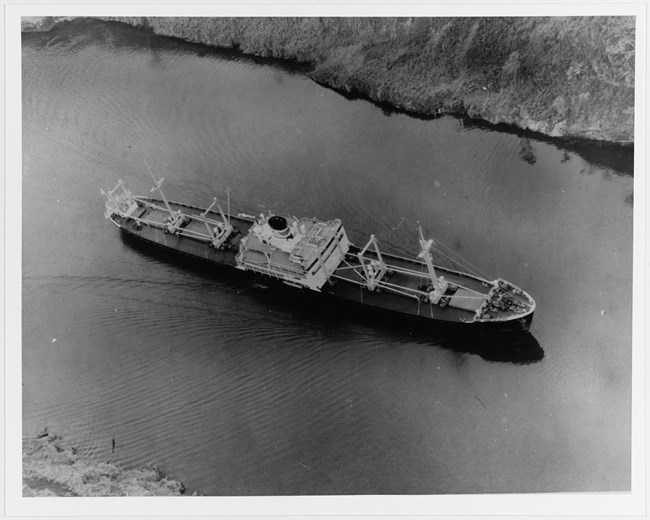Last updated: July 18, 2025
Article
USS Grunion

Naval History and Heritage Command, NH 79757-B
First and Only War Patrol
The USS Grunion was a Gato-class submarine, laid down in 1941 and commissioned in 1942 with Lieutenant Commander Mannert “Jim” Abele in charge. The name “grunion” comes from a California silverside fish (Leuresthes tenuis), known for leaving the water and laying eggs (spawning) on shore.
The USS Grunion left New London, CT and headed for Pearl Harbor, via the Panama Canal. Along the way, her crew spotted 16 survivors on a lifeboat, from the USAT Jack, which had been attacked by a German U-boat. The Grunion rescued the survivors and searched unsuccessfully for additional survivors before delivering them to safety at a Naval Base in Panama. After reaching Pearl Harbor, the Grunion headed out on her first war patrol to the Aleutian Islands.
The USS Grunion and her crew of 70 reached Kiska Island, where they were assigned to patrol, on July 10, 1942. The Japanese had attacked and captured both Kiska and Attu Islands just a month before, at the beginning of June. On July 15, the Grunion reported she had been attacked by an enemy destroyer, fired three torpedoes, and missed. A later report said the Grunion sank three destroyers, but according to Japanese reports, she sank two (patrol boats 25 and 27) and damaged a third.
On July 19, the Grunion was assigned to continue patrolling around Kiska with three other submarines, S-32, Triton, and Tuna. On July 22 and 28, the Grunion was told to guard exits around Kiska, because the US planned to attack the island. The attack happened on July 28, and the Grunion reported attacking an enemy ship but not making any hits. She also was depth charged, but not damaged.
The Grunion’s last transmission to Dutch Harbor Submarine Base was on July 30. There was heavy antisubmarine activity around Kiska, and she had ten torpedoes remaining. She was ordered to return to Dutch Harbor, which was about 600 miles away (about two days of travel). The Grunion was never heard from again, despite many efforts to contact her.

Naval History and Heritage Command, NH 45578
The Kano Maru
There was at least one Japanese transport ship, the Kano Maru in the vicinity of the Grunion on the last days in July. From a translated article by Yutaka Iwasaki in a Japanese seafarer’s magazine (Maru) and written about by Brad Abele, son of Lt. Cmdr. Abele, it seems that the Grunion fired on the Kano Maru. Her captain, Seiich Aiura, wrote, “… . At 05:47 on the morning of July 31st, two torpedoes were spotted coming at it from the starboard quarter. The ship tried in vain to turn into the torpedoes but while the first torpedo passed astern, the second exploded aft at the machinery room on the starboard side. At this time the Kano Maru spotted a periscope of a submarine quite close by on the forward starboard side. The cargo ship hadn’t sunk but its machinery room was flooded, and its generator and its radio were out of commission. The now terrified Japanese seamen, recognizing their helplessness and probable fate had to put all their faith in the one remaining operable 8 cm gun on the forecastle – the one on the stern having been made inoperable by the torpedo hit. This forward located 8cm gun was immediately put into action, as were the 13mm machine guns mounted on its bridge. …”
The translated article continues, “Shortly thereafter, a submarine was spotted surfacing about 400 meters away and aft of the Kano Maru presumably to try to sink the merchant ship with gunfire. The Grunion had now reversed its course 180 degrees, turning away from the cargo ship, and heading once more to the aft of the ship where it might be shielded from the 8 cm gunfire by the superstructure of the Kano Maru. At this point the submarine was bearing 135 degrees off the left stern. Before the sub had fully surfaced and moments before it had passed safely astern, a direct hit was scored on the conning tower by the fourth shot from the 8mm gun, after it had resumed firing, and the submarine disappeared from the scene.”
After returning to Kiska Harbor to repair the damage done by the USS Grunion, the Kano Maru was attacked by Patrol Bombers (PBYs) and sank in shallow water. Most of the cargo on board was salvaged. When the war was over, the Kano Maru was patched up enough to be towed back to Japan for scrap.
Final Pieces
What happens next must be pieced together from analyzing the video footage of the wreck of the Grunion, discovered in 2006 through the Lost 52 Project and the persistence of Lt. Cmdr. Abele's three sons. As Nicholas A. Veronico wrote in his book Hidden Warships: Finding World War II’s Abandoned, Sunk, and Preserved Warships, “the last torpedo [fired] appeared to have been a circular run, not uncommon in those days, that came around and struck the submarine in the periscope shears, but it didn’t explode. The evidence suggests that the sonar man heard the high-pitched whirring of the torpedo as it changed course and the skipper ordered a hard dive to get out of the torpedo’s way. Traveling at 53 miles per hour and weighing 3,500 pounds, a torpedo has the same impact velocity as a small car, so it can do a lot of damage—even if it doesn’t explode. With the hard dive order, the dive planes were put into a downward position, but the submarine was still not able to get out of the torpedo’s way. It was struck in the periscope shears, the structure holding the periscopes, where a significant dent is plainly visible. The torpedo broke both periscopes, in essence blinding the sub, but it did not explode.
“In analyzing the video of the wreck, it was noticed that the rear dive planes were still in the dive position. The analysts surmised that during the descent, the drive planes became jammed, forcing the submarine down at a steep angle from which it was unable to recover. The sub plunged down until it reached about one thousand feet, where it imploded, instantly killing the crew and blowing one hatch open.” Impacting on the ocean floor, the bow of the submarine broke off, and slid about a quarter of a mile from the rest of the wreck. The bow was later discovered in 2018.
After being lost at sea for 64 years, the final resting place of the Grunion and her crew of 70 men was found, and the mystery of what happened to her has been solved.
List of the Grunion's Crew
|
Name |
Rate |
Name |
Rate |
|
Abele, Mannert L. |
LCDR-CO |
Lunsford, Samuel, Jr. |
EM2 |
|
Alexander, Frank E. |
SM3 |
Lyon, J.W. |
F1 |
|
Allen, Daniel E. |
SM3 |
Martin, Carson R. |
CMoMM |
|
Arvan, Herbert J. |
MA2 |
Martin, Thomas E. |
EM1 |
|
Banes, Paul E. |
CMoMM |
Mathison, Ryder |
EM1 |
|
Bedard, Leo J.I. |
CMoMM |
McCutcheon, Richard G. |
TM3 |
|
Blinston, Wesley H. |
RM3 |
McMahon, John M. |
LT |
|
Bonadies, Nicholas R. |
S1 |
Miller, E.C. |
F2 |
|
Boo, Robert F. |
EM3 |
Myers, David O. |
F1 |
|
Bouvia, Chester L. |
MM1 |
Nave, Frank T. |
MoMM2 |
|
Caldwell, George E. |
CEM |
Newcomb, Arthur G. |
RM1 |
|
Carroll, Richard H. |
S2 |
Nobles, John W. |
MoMM1 |
|
Clift, John S. |
TM2 |
Pancoast, Jack E. |
MoMM2 |
|
Collins, Michael F. |
F2 |
Parziale, Carmine A. |
TM3 |
|
Cooksey, Lee D. |
MoMM1 |
Paul, Cornelius, Jr. |
MA2 |
|
Cullinane, Daniel |
CMoMM |
Pickel, Bernard J. |
S1 |
|
Cuthbertson, W.H., Jr. |
ENS |
Post, Arnold C. |
S2 |
|
Deaton, Lawrence D. |
S2 |
Randall, William H. |
RM2 |
|
DeStoop, Albert E. |
CTM |
Ryan, Loyal, Jr. |
S2 |
|
Dighton, Samuel R., Jr. |
LTJG |
Sanders, Howard A. |
MoMM1 |
|
Devaney, William P., Jr. |
S2 |
Schumann, Elmer T. |
CQM |
|
Doell, Louis H., Jr |
RM2 |
Sullivan, Paul P. |
PhM1 |
|
Franck, Leon H. |
S1 |
Surofcheck, Steven |
SC1 |
|
Graham, Merritt D. |
CTM |
Swartwood, David N. |
S2 |
|
Hall, Kenneth E. |
S2 |
Templeton, Samuel A. |
GM1 |
|
Helensmith, Ernest G. |
EM3 |
Thomas, Millener W. |
LT-XO |
|
Henderson, Hollice B. |
MoMM2 |
Traviss, Byron A. |
S2 |
|
Hutchinson, Charles R. |
TM3 |
Ullmann, Albert |
S1 |
|
Kennedy, Sylvester J. |
MoMM2 |
Van Voggelum, Marshall F. |
F3 |
|
Knowles, Edward E., Jr. |
S2 |
Walter, Melvin H. |
F3 |
|
Kockler, Lawrence R. |
TM1 |
Webster, Raymond E. |
EM2 |
|
Kornahrens, William G. |
LTJG |
Welch, Donald F. |
FC2 |
|
Ledford, Moore J. |
CY |
Wells, John H. |
TM2 |
|
Lehman, Woodrow W. |
EM1 |
Wilson, John E., Jr. |
SC3 |
|
Loe, Sidney A. |
MoMM2 |
Youngman, Ralph J. |
F2 |
Additional Information and References
- "Jim" essay written by his son Brad Abele (pdf)
- Lost 52 Project's Two Grunion Expeditions
- National Park Service's Cultural Landscape of the World War II Battlefield of Kiska, Aleutian Islands (pdf)
- Naval History and Heritage Command's Summary on the Loss of USS Grunion
- Naval History and Heritage Command's History of the USS Grunion
- Navy Rank Abbreviations
